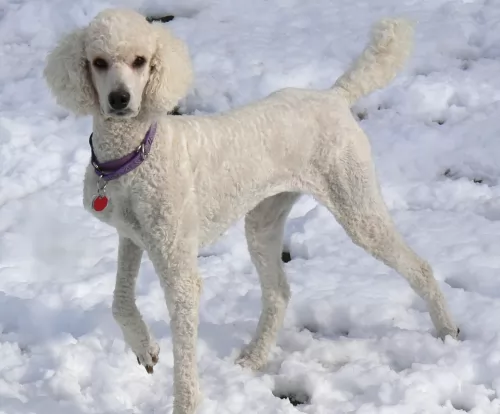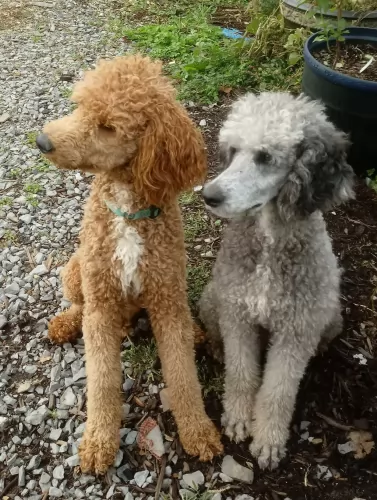 Petzlover
Petzlover Poodle is originated from Germany but Canadian Eskimo Dog is originated from Canada. Poodle may grow 28 cm / 11 inches shorter than Canadian Eskimo Dog. Poodle may weigh 6 kg / 13 pounds lesser than Canadian Eskimo Dog. Both Poodle and Canadian Eskimo Dog has same life span. Both Poodle and Canadian Eskimo Dog has same litter size. Poodle requires High Maintenance. But Canadian Eskimo Dog requires Moderate Maintenance
Poodle is originated from Germany but Canadian Eskimo Dog is originated from Canada. Poodle may grow 28 cm / 11 inches shorter than Canadian Eskimo Dog. Poodle may weigh 6 kg / 13 pounds lesser than Canadian Eskimo Dog. Both Poodle and Canadian Eskimo Dog has same life span. Both Poodle and Canadian Eskimo Dog has same litter size. Poodle requires High Maintenance. But Canadian Eskimo Dog requires Moderate Maintenance
 Poodles are said to be older breed which is developed to hunt waterfowl. They have their origin in Germany and developed as a breed in France. Many different arguements are there in their development. One of the arguement says that they are developed as a result of crossing European Water dogs. Egyptian and Roman histories have proof of Poodles in their drawings and statues. They were categorized into three types according to their size and are Miniature, Toy and Standard.
Poodles are said to be older breed which is developed to hunt waterfowl. They have their origin in Germany and developed as a breed in France. Many different arguements are there in their development. One of the arguement says that they are developed as a result of crossing European Water dogs. Egyptian and Roman histories have proof of Poodles in their drawings and statues. They were categorized into three types according to their size and are Miniature, Toy and Standard.
 The Canadian Eskimo Dog dates way back to more than 4,000 years ago. This Arctic breed of dog was developed to pull sleds, and wasn’t considered as a pet but as a working dog – an important means to an end – a tool for use.
The Canadian Eskimo Dog dates way back to more than 4,000 years ago. This Arctic breed of dog was developed to pull sleds, and wasn’t considered as a pet but as a working dog – an important means to an end – a tool for use.
By the 1960s the dog breed had declined to such an extent that they were removed from UKC and AKC registries. It is believed that the breed would have in all likelihood become extinct if it weren’t for the efforts of Brian Ladoon, William Carpenter and John McGrath who formed the Eskimo Dog Research Foundation in 1972.
After breeding for 30 years, the dog has the biggest genetic stock colony of Canadian Eskimo Dogs and in May 2000, Nunavut, a Canadian territory, adopted the dog as the animal symbol for this region.
 Poodles today lives a luxury life but actually they are bred to do work. They are well known for their intelligence and are really water retriever. This is because they show their energy in hunting waterfowl. The name Poodle is said to got from German word "Pudel" which means "splash in the water".
Poodles today lives a luxury life but actually they are bred to do work. They are well known for their intelligence and are really water retriever. This is because they show their energy in hunting waterfowl. The name Poodle is said to got from German word "Pudel" which means "splash in the water".
Their hair is trimmed in such a way to make them swim easily. Hair is not trimmed in the joints and organs such that to protect them from cold water. Poodles are well known for their wonderful personality and intelligence. Also they are very obedient and a good companion. They won't be happy if left alone for a long time. Poodles are interested in playing games with people. They perform very well if given a proper training. Good manners should be taught to them as they remember all things they have learned.
 The Canadian Eskimo Dog is a well-built, medium- to large sized dog looking much like a husky. The male Eskimo dog is somewhat bigger than the female, standing 58 – 70cm at the shoulder and weighing 30 - 40kg.
The Canadian Eskimo Dog is a well-built, medium- to large sized dog looking much like a husky. The male Eskimo dog is somewhat bigger than the female, standing 58 – 70cm at the shoulder and weighing 30 - 40kg.
The male often has some thick fur around the neck, giving him the appearance of looking larger than he actually is. He is slightly larger than the female. Other people say he has a similar appearance to a wolf.
He has a thick double coat which can be white, gray, fawn or even black and white. He has short, erect ears, dark brown eyes and a bushy, feathered tail which curls over the back. Sometimes you find blue eyes with the Canadian Eskimo Dog, and its only when you want to show him, that this isn’t acceptable.
The Canadian Eskimo Dog's temperament is hard working, tough, brave, alert and intelligent. When he is trained and socialized, which will be important for this breed, he becomes gentle and loving, forming a strong bond with his owner. He’ll also get along well with children in the home as well as other pets.
 They are good companions and usually likes to spend time with children. Even they are children friendly it is strongly recommended not to leave children alone with them.
They are good companions and usually likes to spend time with children. Even they are children friendly it is strongly recommended not to leave children alone with them.
Poodles are specialist in hunting water birds. They are good in swimming since they are covered with fur water will not easily get into their ears. They are well known for their intelligence like humans.
They are well suited for apartment living but won't be happy if left alone. They will tolerate hot weather better when compared with cold.
They are quick learners and learn good and bad things very quickly. Once they learn, they won't forget it up. Since poodles are so intelligent they are very easy to train.
 The Canadian Eskimo Dog is a dog which is responsive to training. With training and socialization, as a highly intelligent, strong-will dog he will need to be supervised by a firm, authoritative figure.
The Canadian Eskimo Dog is a dog which is responsive to training. With training and socialization, as a highly intelligent, strong-will dog he will need to be supervised by a firm, authoritative figure.
He makes such an awesome pet when properly trained, and if you’re a responsible dog owner who knows how to care for- and exercise your pet appropriately, you’ll be rewarded by having a strong, loving companion at your side.
 Poodles have more chances for getting eye diseases such as Progressive retinal atrophy and cataracts. Cancer is also seen in them and there are chances of skin problems such as allergies and tumors.
Poodles have more chances for getting eye diseases such as Progressive retinal atrophy and cataracts. Cancer is also seen in them and there are chances of skin problems such as allergies and tumors.
Usually poodles don't shed at all. Excessive shedding is the smptom of allergies in them. When they get other problems shedding accompanies with it. Even an infection may cause hairfall. Ringworm infections and pests should be controlled using appropriate medicines.
 The Canadian Eskimo Dog is a generally healthy breed who has a life expectancy of between 10 and 15 years when he is lovingly cared for and provided with a top quality diet. Ensure that he has a top quality diet with plenty of raw meat geared towards his age and energy levels.
The Canadian Eskimo Dog is a generally healthy breed who has a life expectancy of between 10 and 15 years when he is lovingly cared for and provided with a top quality diet. Ensure that he has a top quality diet with plenty of raw meat geared towards his age and energy levels.
The Canadian Eskimo Dog suffers from common health issues that most dogs are at risk for, and typically this will include hip dysplasia and eye disease. If your dog develops a disease such as hip dysplasia, speak to your vet immediately.
 Usually puppy eats more food than an adult dog. This is because they need more food to support growth. Actully puppies need two to four times more food than adult. Puppies should eat in such a way that their ribs should not be seen and waist must be visible.
Usually puppy eats more food than an adult dog. This is because they need more food to support growth. Actully puppies need two to four times more food than adult. Puppies should eat in such a way that their ribs should not be seen and waist must be visible.
Poodles can be fed with proteinous food, healthy grains, vegetables and fruits. They love to eat organs such as liver, kidney, brain and chicken breast, turkey and fish. Vegetables such as baby carrots, spinach and peas can be given to them. Make them to eat fruits like raspberries, banana and melon.
Dry kibble is not good for their teeth. Even some premium quality foods are not good for their health. Pig's ears are not safe to chew for them. Vaccinations should be made at the right time.
Exercises play an important role in their health and even extend their life. Poodles should be made to walk regularly. Exercising must be done to a particular level and they should not be over exercised.
 The Canadian Eskimo Dog has always been a working dog, used to being driven hard to perform, and to this day he likes to work hard and have his day filled with activities.
The Canadian Eskimo Dog has always been a working dog, used to being driven hard to perform, and to this day he likes to work hard and have his day filled with activities.
His exercise requirements are high and this is one breed that you’re going to have to exercise regularly – long walks, running on a leash as you cycle, ball games, swimming, hiking. It is why the dog is best suited for life in the country as opposed to small properties in the city. If exercise seems like a lot of hard work for you, don’t buy such a breed as it will be cruel and irresponsible to leave him day after day in your back yard. He becomes bored, frustrated, unhappy and destructive.
The dog is an average shedder and his coat is short and dense. There’s not a whole lot of maintenance to worry about with this good-looking dog and he will basically require having a good brush twice a week.